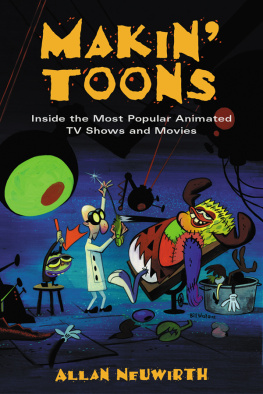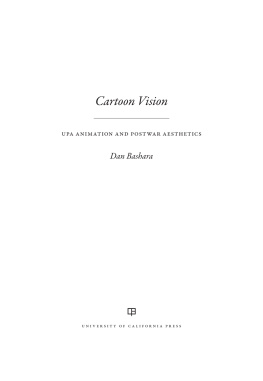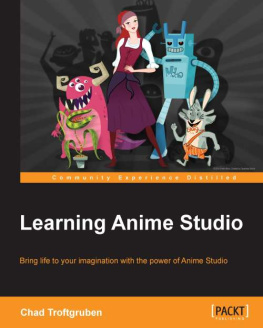MAKIN
TOONS
Inside the Most Popular Animated
TV Shows and Movies
ALLAN NEUWIRTH

2003 Allan Neuwirth
All rights reserved. Copyright under Berne Copyright Convention, Universal Copyright Convention, and Pan-American Copyright Convention. No part of this book may be reproduced, stored in a retrieval system, or transmitted in any form, or by any means, electronic, mechanical, photocopying, recording, or otherwise, without prior permission of the publisher.
08 07 06 05 04 03 5 4 3 2 1
Published by Allworth Press
An imprint of Allworth Communications
10 East 23rd Street, New York, NY 10010
Cover design by Mary Belibasakis
Cover illustration by Bill Wray
Page composition/typography by Susan Ramundo
Library of Congress Cataloging-in-Publication Data
Neuwirth, Allan.
Makin toons : inside the most popular animated TV shows and movies / by Allan Neuwirth.
p. cm.
Includes bibliographical references and index.
ISBN 1-58115-269-8 (pbk.)
1. Animated television programsUnited States. 2. AnimatorsUnited StatesInterviews. 3. Motion picture producers and directorsUnited StatesInterviews. I. Title.PN1992.8.A59 N48 2003
791.453dc21
2003000759
Printed in Canada
For Rowan and Duncan
ACKNOWLEDGMENTS
To all of my talented colleagues who contributed to Makin Toons: Thank you. Without your help, theres no way I could have realized this project. In particular, my editors, Liz Van Hoose, Jessica Rozler, and Nicole Potter, and publisher Tad Crawford, for your guidance; my good friends and frequent collaborators Gary Cooper and Glen Hanson, for your insights; Susan and Eric Goldberg, who unlocked many doors (and shared so much of the animation trivia stored in the Cartoon Coloured vault also known as Erics brain); Linda Simensky, who threw the portals wide open at Cartoon Network; and my sister Risa Neuwirth, animator Raul Garcia, writer/cartoonist Angelo DeCesare, and production manager Masako Kanayama, for your feedback and assistance. An extra special thank-you goes out to Bill Wray, for that fabulous and witty cover painting.
There are so many who made my research and/or image-gathering phase much easierincluding the ever-amazing Howard Green and Susan Butterworth at Walt Disney Feature Animation; Margaret Adamic at Walt Disney Publishing Worldwide; Courtenay Purcell, Megan Trikilis, Joe Swaney, Diana Ritchey, and John Cawley at Cartoon Network; Kyle Feeley and Lorri Bond at Warner Bros. TV Animation; Nathan Johnson, Nicole Mazer, Richard Betz, and Tashna Newman at Nickelodeon; Jeffrey Katzenberg and Terry Press at DreamWorks; Steven Argula at Pixar; Kevin Kolde at Spumco; Tiffany Ward and Trish Lamkin at Jay Ward Productions; Linda Zazza at Blue Sky; Rick Kunis at Alan Menkens studio; Jessica Jarrett at King of the Hill; photographer Greg Preston; Pam Martin at Cel-ebration Gallery; and TheDigitalBits.coms Greg Suarez; and Collecting-Simpsons.coms Bill LaRue, for sharing their Simpsons interview material.
Humble thanks also go to the late Nina Bamberger, whom I dearly miss, as well as Andrew Adamson, Roger Allers, Billy Aronson, Ken Bruce, Pat Carroll, Jean Chalopin, Brenda Chapman, Ron Clements, Vanessa Coffey, Gabor Csupo, Andreas Deja, John R. Dilworth, Paul Dini, Pete Docter, Ben Edlund, June Foray, Paul Germain, Michael Giaimo, Eric Goldberg, Susan Goldberg, Marty Grabstein, Don Hahn, Mary Harrington, Stephen Hillenburg, Scott Johnston, Mike Judge, Helen Kalafatic, John Kricfalusi, Bill Lauch, John Leguizamo, Richard Liebmann-Smith, Craig McCracken, Shaun McLaughlin, Kent Melton, Alan Menken, Candy Monteiro, Glen Murakami, John Musker, Sue Nichols, Steven Orich, Gyorgyi Kovacs Peluce, Margot Pipkin, Don Poynter, Eric Radomski, Dave Reynolds, Fredda Rose, Will Ryan, Chris Savino, Thomas Schumacher, Linda Simensky, Tom Sito, Arnold Stang, Andrew Stanton, Genndy Tartakovsky, Terry Thoren, James Tucker, Alan Wagner, Teale Wang, Aron Warner, Chris Wedge, Billy West, Scott Wills, Gary K. Wolf, and Bill Wray, who all generously agreed to share their experiences with me.
INTRODUCTION
Hi. My name is Allan. Like many of you out there, Im a toon-a-holic.
My addiction began at the tender age of four, when my parents gave me my first TV set, an old black-and-white Zenith. No sooner had they placed it at the foot of my bed that I began what was to become my early morning ritual: open my eyes, scamper across the covers to flip the set on, then sit there mesmerized by the cartoon images flickering before me.
Dogs chasing cats cats chasing mice mice tricking cats cats tricking dogs. A hapless coyote hurtling off a cliff. Bears stealing picnic baskets. A blustering southern rooster and a pugnacious chicken hawk. A cowboy horse and his Mexican burro sidekick. A prehistoric construction worker powering the family car with his bare feet. A cheerful mouse and his inquisitive pet dog. A wascally wabbit outwitting a host of verbally challenged, dim-witted adversaries. A plucky flying squirrel and a moose of dubious intellect.
And so many catchphrases, all permanently etched into my brain: Eh, whats up, Doc? Exit, stage left! Youre dethpicable! Watch me pull a rabbit outta my hat! Yabba dabba do! Vhat is plan, darlink? Smarter than the average bear! Jane, stop this crazy thing! I tawt I taw a puddy tat! Aaaaaalvin!!!
The toons were chaotic, wildly funny, and often sly and subversive. They fueled my imagination and helped form my comic sensibilities.
A year or two later, my mother began taking me to the movies with her, to see all the great animated features. Lady and the Tramp was the first, followed soon after by One Hundred and One Dalmatians, Gay Purr-ee, The Jungle Book, Pinocchio, and on and on. Suddenly, I wasnt just laughing at wild antics anymoreeven though I was a young kid, I found myself absorbed by the narratives and pacing of the longer form. Oh, I still laughed, but now I was also thrilled, frightened, and sometimes moved to tears.
As I got a bit older, I realized I could actually draw these characters and put them through adventures of my own devisingwhich I proceeded to do, night and dayan experience thats shared, not surprisingly, by so many others whom youll read about in this book. To the complete and utter mortification of my parents, I drew em on everything: my clothes, their clothes, painted walls, wallpapered walls, napkins, fine tablecloths, my dads handkerchiefs, the margins of books, the soles of my own feet and even, occasionally, on paper. Wherever there was a clean surface, it was soon covered with images resembling Bullwinkle, Yogi Bear, Crusader Rabbit, or Mickey Mouse. My manic obsession with toons had taken root.
But by far the greatest discovery of all was that amazing little device called the flipbook. I learned that if I stapled a small stack of paper together at the bottom, drew slightly progressive poses in sequence, and then riffled through the pages, my drawings could actually movejust like the ones on TV. So thats how they did itor, at least, I thought it was that simple.
Years later, of course, I learned what an involved and rich process the act of creating animation actually isall about the writing and designing and directing and producing, and storyboards, layouts, timing, voice recording, music, sound effects, mixing, and editing that go into making a cartoon series or film. Once I was gainfully employed in the animation field, my parents would remind me of how Id declared my intentions at the age of seven to make cartoons. I have no reason to doubt it.
My friends and Iand certainly most of you, if youre reading these wordsgrew up addicted to animation, consumed by our passion for it. Clearly, we werent alone. Aside from the odd curmudgeon or two out there,
Next page







